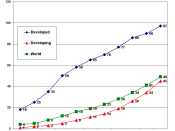IntroductionThis literature review is focused on international and U.K evaluations ofÃÂtechnology-richÃÂ information and communication technologies (ICT) initiatives inschools from 1990 onwards. This review is written for an audience of researchers, policymakers, and educators.
The projects reviewed here attempted to lessen the digital divide, that is, they providedstudents of low socio-economic status (and in some cases families and communities), andthose in isolated areas, with increased access to technology. In particular, evaluations ofICT initiatives that included empirical evidence about the effects of the processes andoutcomes of these initiatives are examined. The purpose of this review is to provideinformation about the evaluation of these ICT initiatives, and summarise the findings ofthese initiatives, to inform the evaluation of the four Digital Opportunities projectscurrently underway in a number of U.K schools. The review concernsevaluations of projects that are considered relevant, but not necessarily limited to, the ICTdelivery methods that are being implemented as part of the four Digital Opportunitiesprojects.
A secondary aim of this review is to inform policy developments in the area ofICT use in schools. For this reason this review includes an overview of otherinternational initiatives that are designed to introduce effective ICT strategies in lowdecile schools and the schoolsÃÂ communities.
The bulk of the review concerns projects located in upper primary and secondaryschools, though information from elementary schools in the United States and primaryschools in other countries has been included where relevant.
This review is in four sections; the first provides background on the literature review,the digital divide, and the Digital Opportunities projects in U.K; the secondoverviews briefly international initiatives similar to the Digital Opportunities projects; thethird summarises information from evaluations and research of projects similar to the fourDigital Opportunities projects; and the fourth presents conclusions.
EVALUATIONSEvaluation DesignsThere are a number of models and approaches to evaluation,


